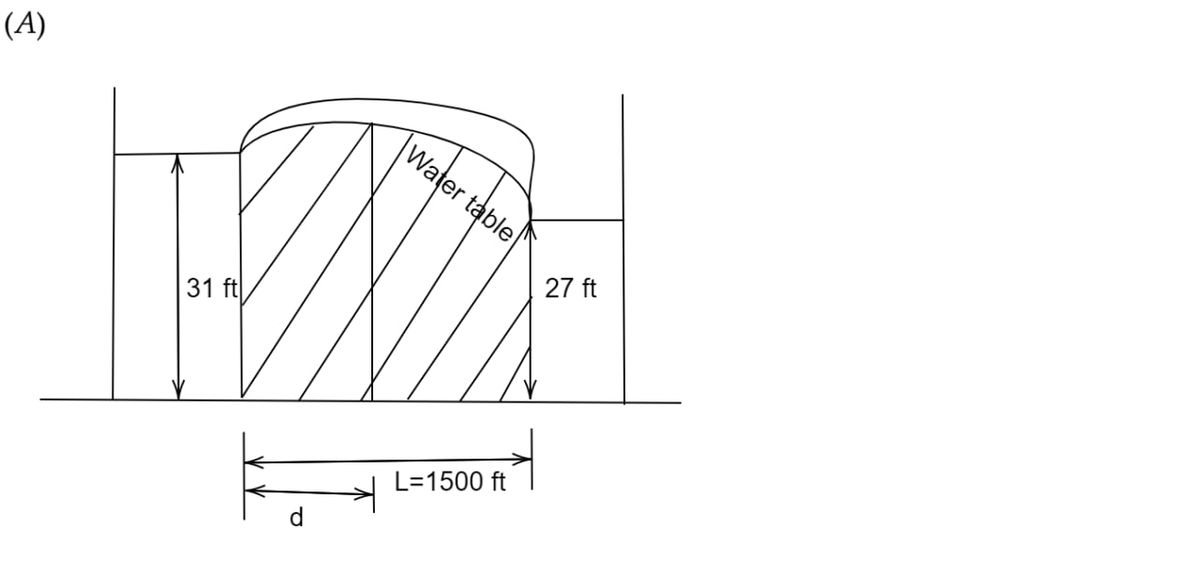e of the aquifer is 31 feet, and the elevation of the water in the canal above the base of the ifer is 27 feet. Sketch a cross-section of the system, including the impermeable bottom of the aquifer, the canal, the river, and the approximate expected elevation of the water table. Find (1) the location of the groundwater divide, (2) the maximum height of the water table, and the total volume of water entering (3) the river each year (per 1,000 ft length of river), and the total volume of water entering (4) the canal each year (per 1,000 ft length of canal).
e of the aquifer is 31 feet, and the elevation of the water in the canal above the base of the ifer is 27 feet. Sketch a cross-section of the system, including the impermeable bottom of the aquifer, the canal, the river, and the approximate expected elevation of the water table. Find (1) the location of the groundwater divide, (2) the maximum height of the water table, and the total volume of water entering (3) the river each year (per 1,000 ft length of river), and the total volume of water entering (4) the canal each year (per 1,000 ft length of canal).
Chapter2: Loads On Structures
Section: Chapter Questions
Problem 1P
Related questions
Question
3

Transcribed Image Text:A canal runs parallel to a river 1,500 feet away. Both fully penetrate an
unconfined sand aquifer with a hydraulic conductivity of 1.2 feet/day. Local precipitation is 1.80
ft/year and local evapotranspiration is 1.30 ft/yr. The elevation of the water in the river above the
base of the aquifer is 31 feet, and the elevation of the water in the canal above the base of the
aquifer is 27 feet.
a.
b.
Sketch a cross-section of the system, including the impermeable bottom of the
aquifer, the canal, the river, and the approximate expected elevation of the water table.
Find (1) the location of the groundwater divide, (2) the maximum height of the
water table, and the total volume of water entering (3) the river each year (per 1,000 ft length
of river), and the total volume of water entering (4) the canal each year (per 1,000 ft length of
canal).
Expert Solution
Step 1

Step by step
Solved in 4 steps with 4 images

Knowledge Booster
Learn more about
Need a deep-dive on the concept behind this application? Look no further. Learn more about this topic, civil-engineering and related others by exploring similar questions and additional content below.Recommended textbooks for you


Structural Analysis (10th Edition)
Civil Engineering
ISBN:
9780134610672
Author:
Russell C. Hibbeler
Publisher:
PEARSON

Principles of Foundation Engineering (MindTap Cou…
Civil Engineering
ISBN:
9781337705028
Author:
Braja M. Das, Nagaratnam Sivakugan
Publisher:
Cengage Learning


Structural Analysis (10th Edition)
Civil Engineering
ISBN:
9780134610672
Author:
Russell C. Hibbeler
Publisher:
PEARSON

Principles of Foundation Engineering (MindTap Cou…
Civil Engineering
ISBN:
9781337705028
Author:
Braja M. Das, Nagaratnam Sivakugan
Publisher:
Cengage Learning

Fundamentals of Structural Analysis
Civil Engineering
ISBN:
9780073398006
Author:
Kenneth M. Leet Emeritus, Chia-Ming Uang, Joel Lanning
Publisher:
McGraw-Hill Education


Traffic and Highway Engineering
Civil Engineering
ISBN:
9781305156241
Author:
Garber, Nicholas J.
Publisher:
Cengage Learning